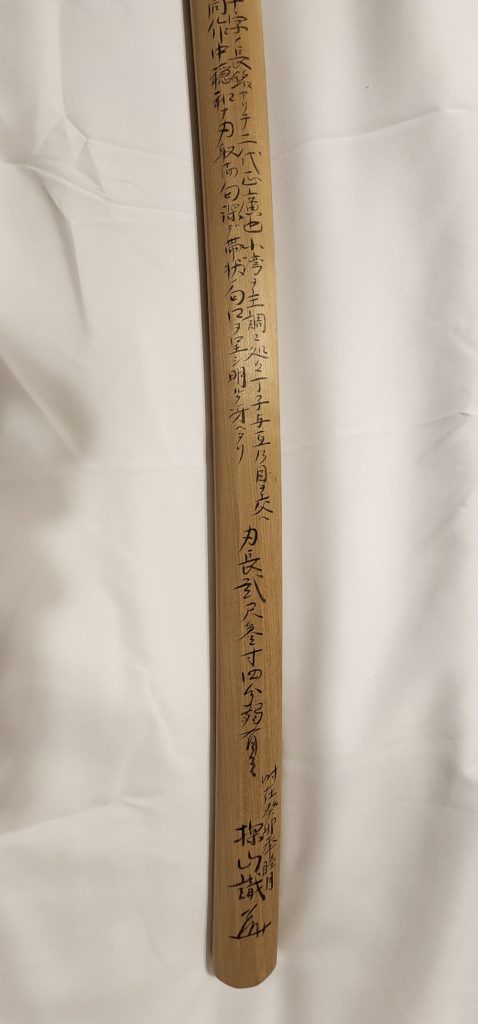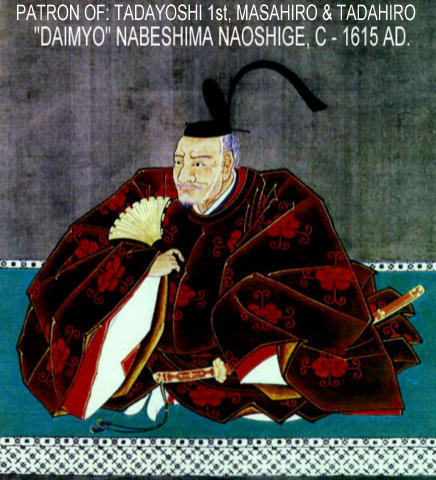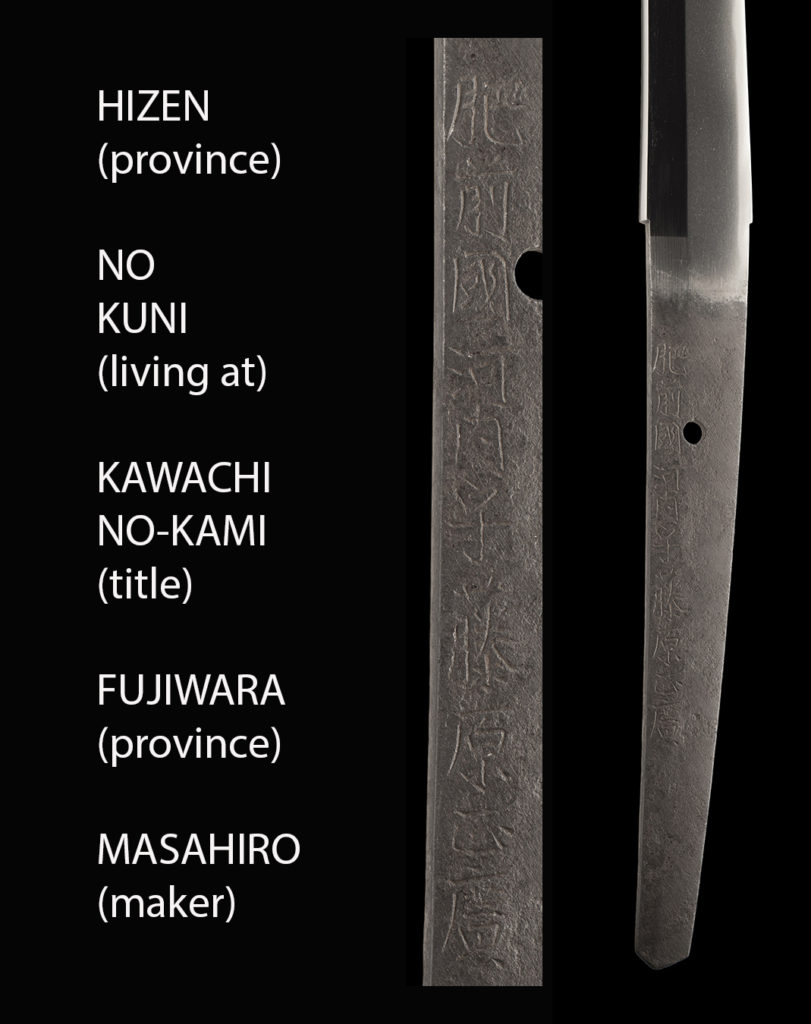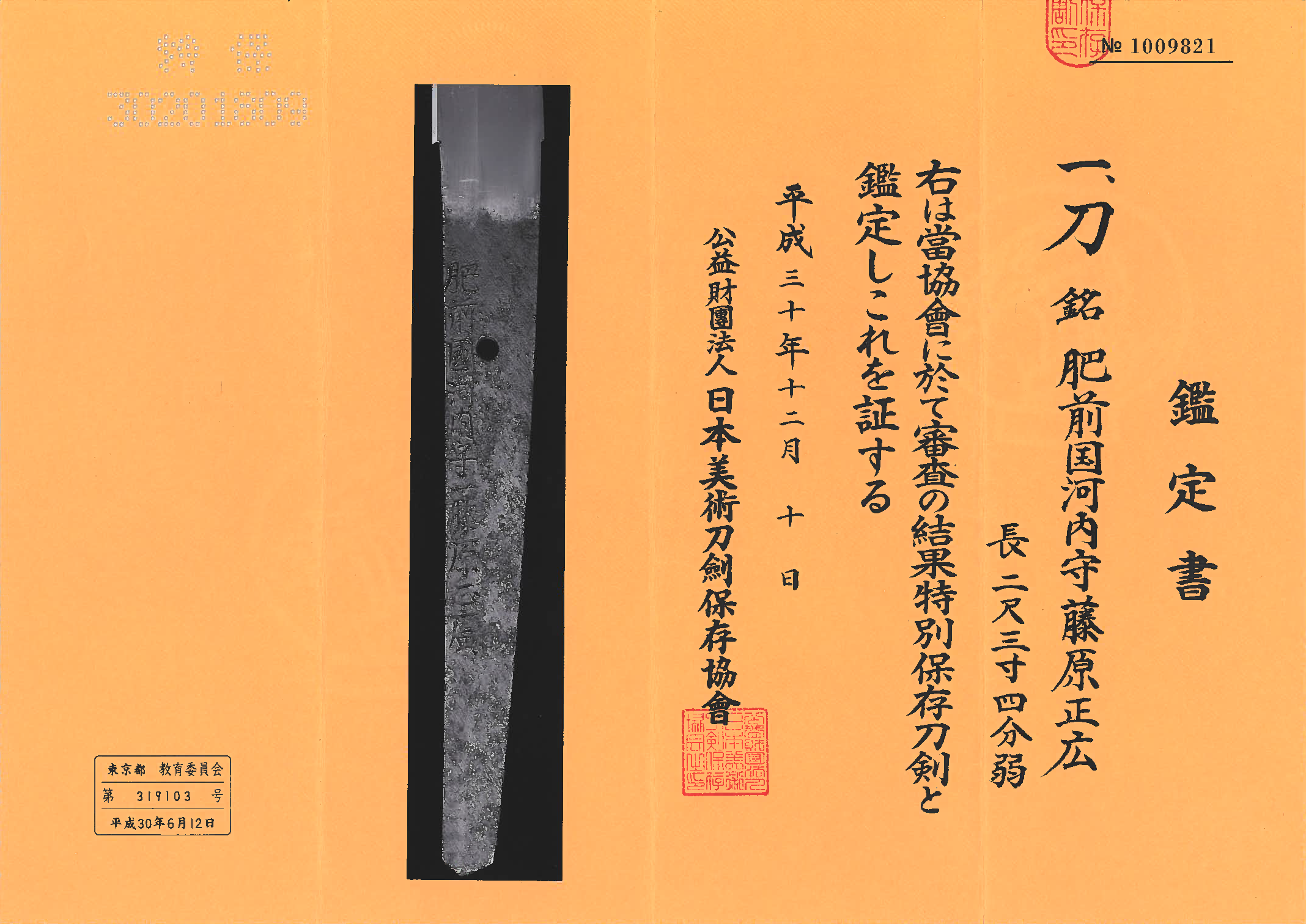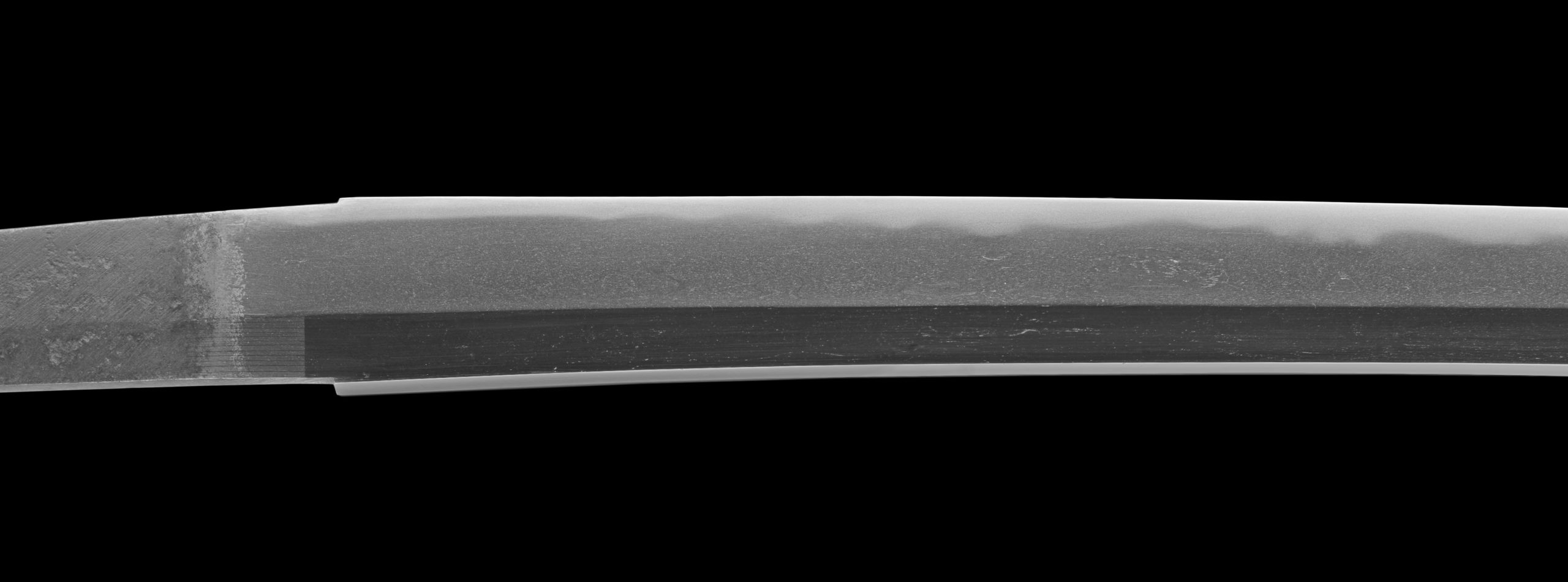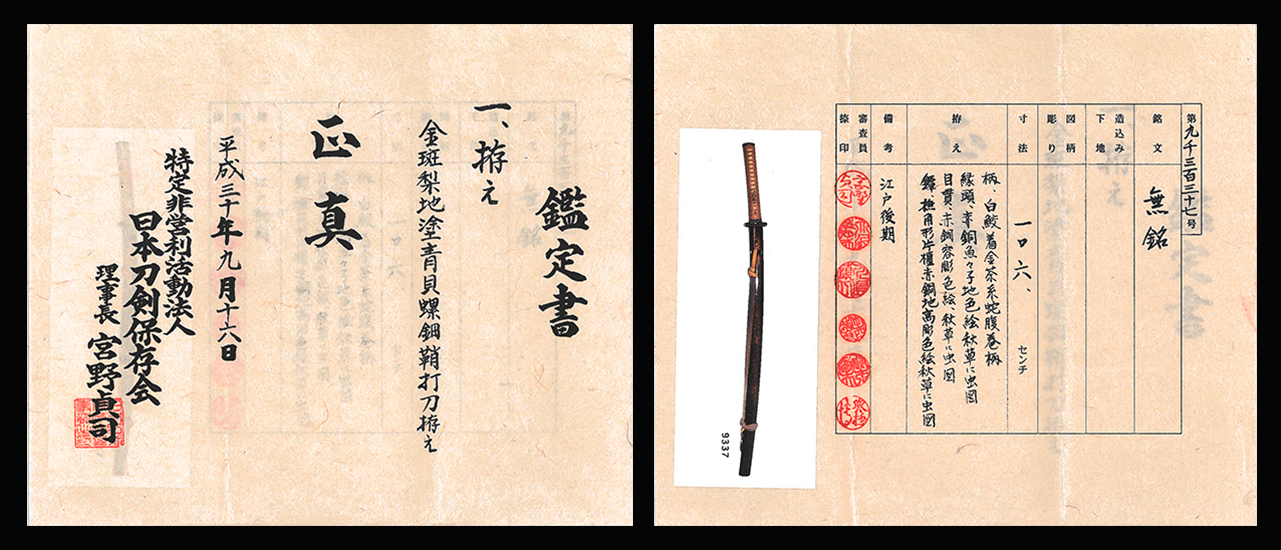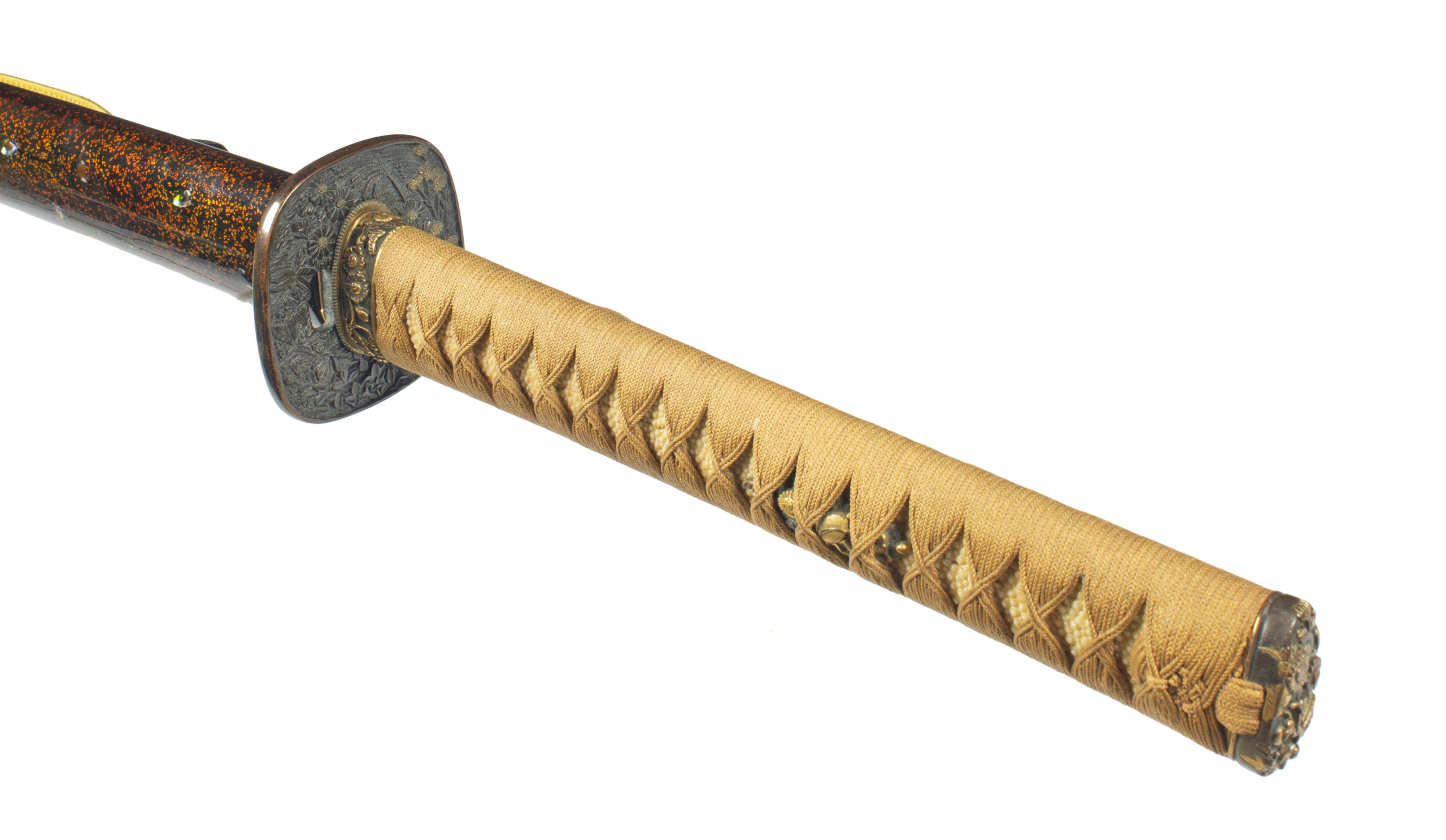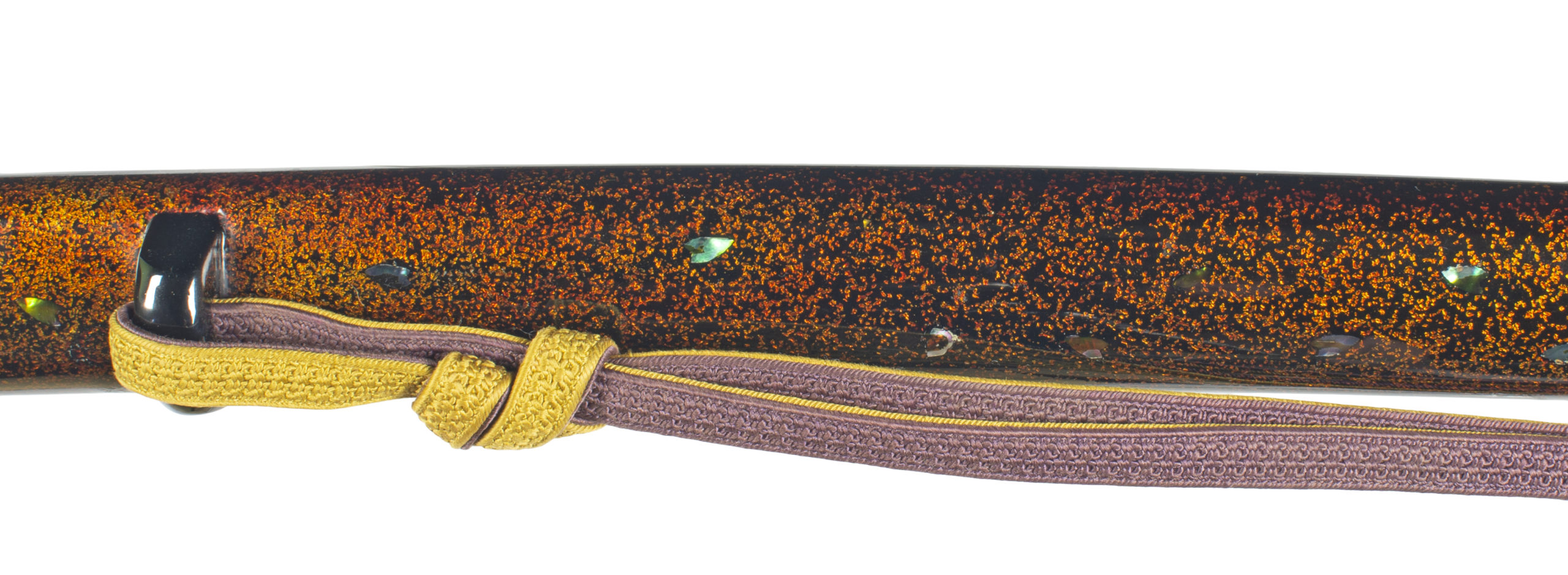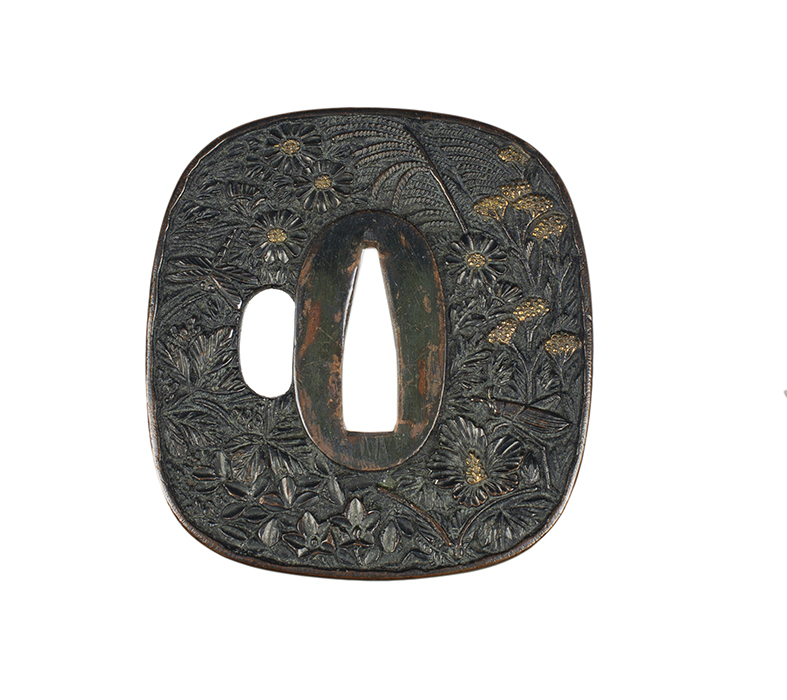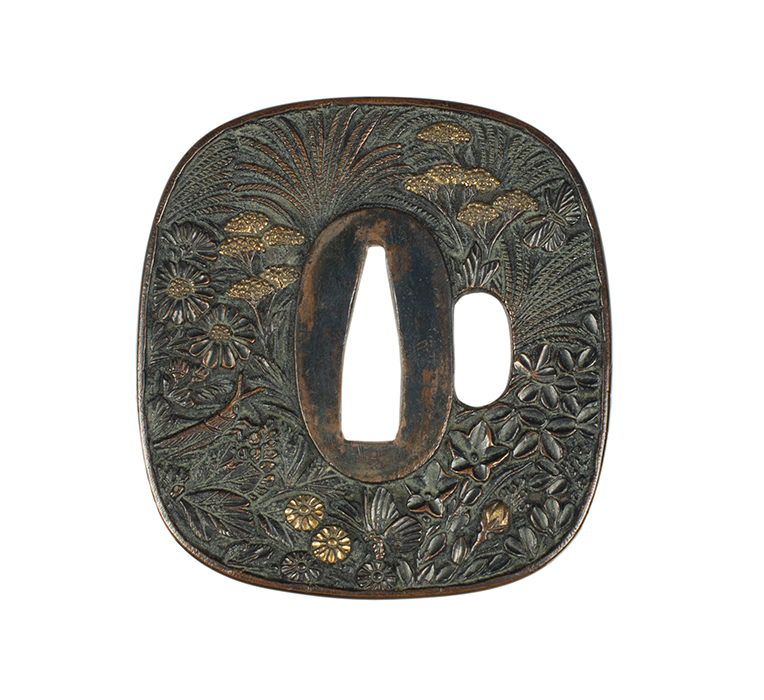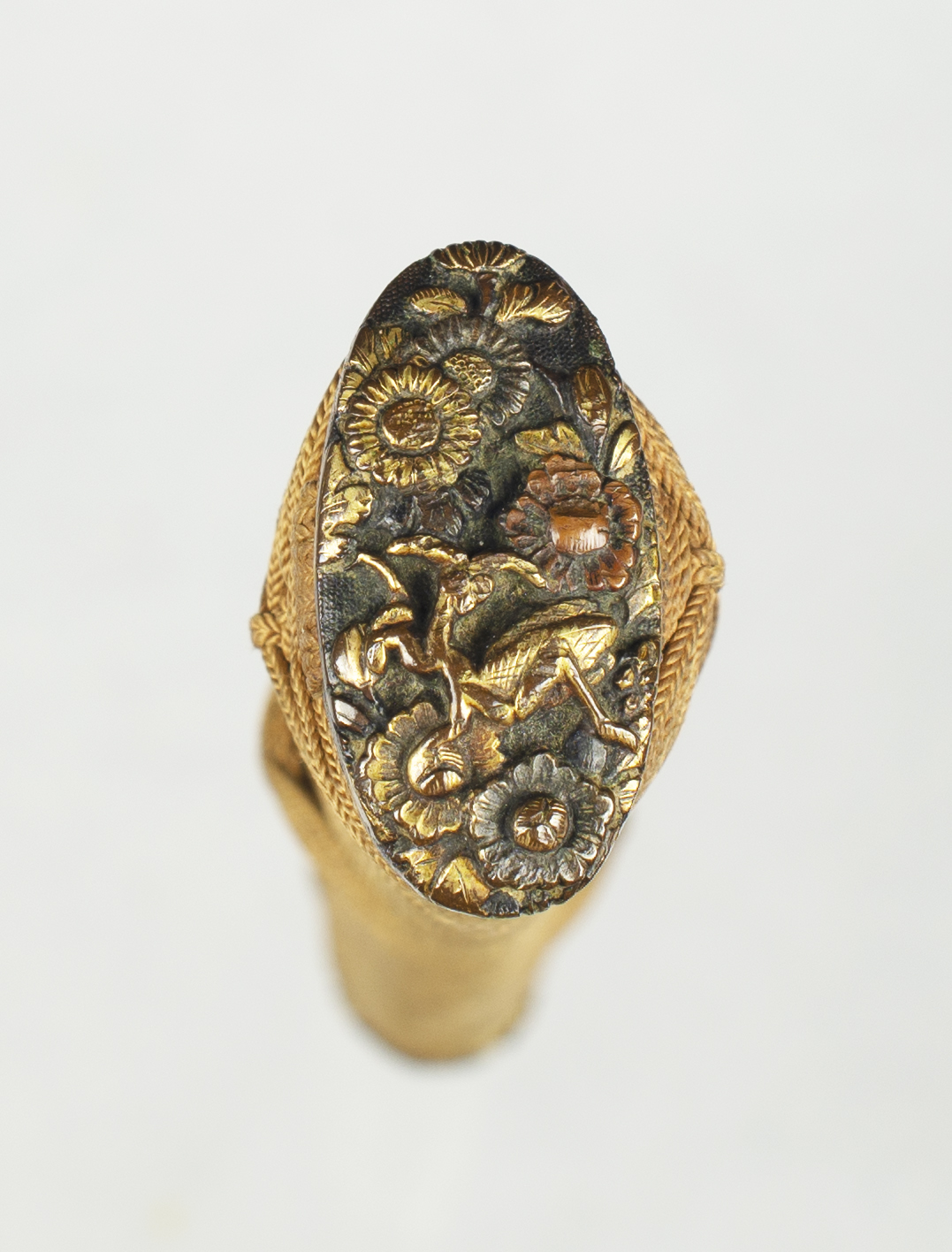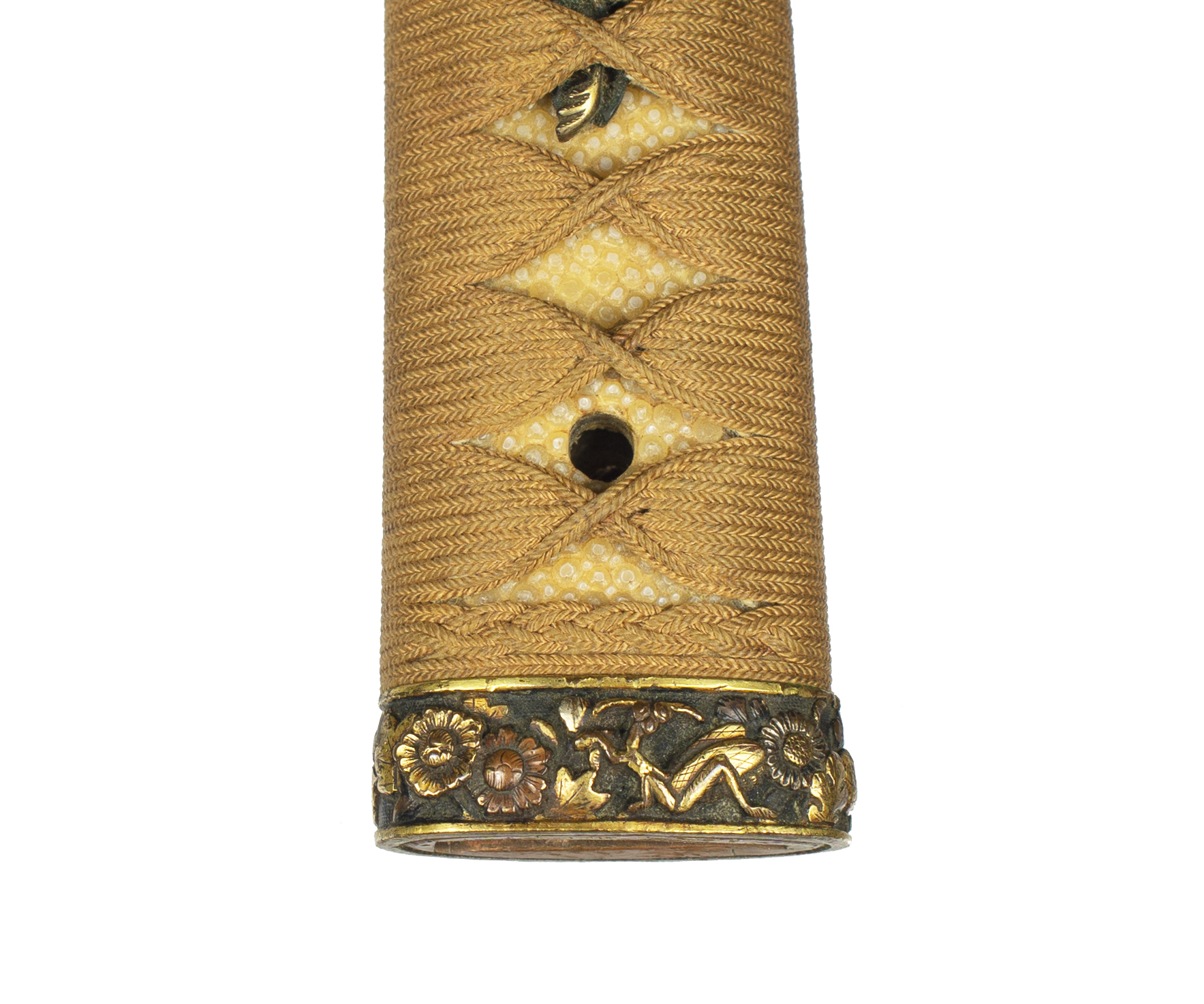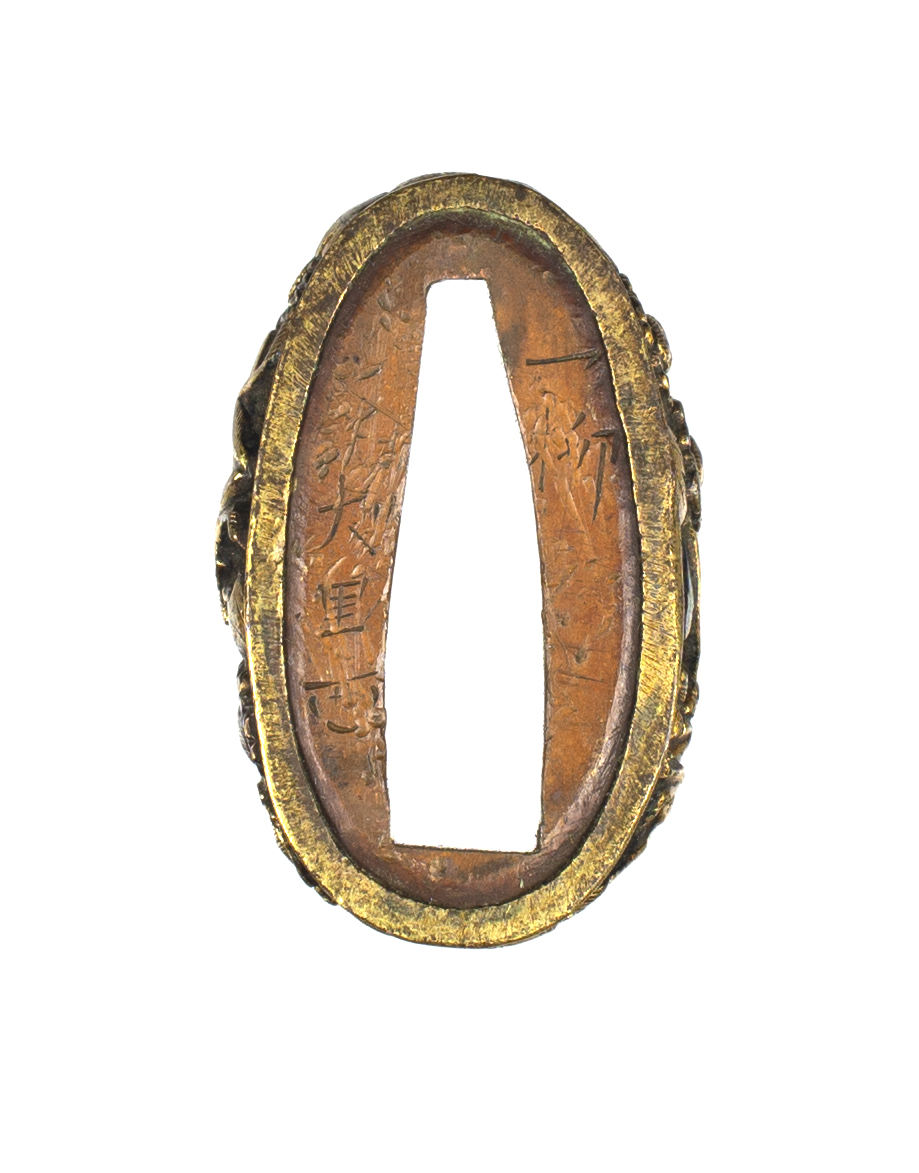nidai / 2nd GEN., HIZEN MASAHIRO
NBTHK Tokubetsu Hozon
Rated “upper class” (Jo – Saku)
Tanobe Michihiro (Tanzan) sensei sayagaki
Fittings: Mino Goto school with flowers and praying mantis
Saya: with Gold-speckled nashiji lacquer and diverse mother-in-pearl accents
Hizen no Kuni Kawachi no Kami Fujiwara Masahiro
(肥前國河内守藤原正廣) 2nd Generation/ nidai
This is a Hizen Masahiro nidai (2nd generation) signed Hizen no Kuni Kawachi no Kami Fujiwara Masahiro (肥前國河内守藤原正廣). This was made in 1665 or later before his death, we know this to be true because Masahiro nidai received a new title of Kawachi no Kami on April 13th, 1665 in the same year of his fathers passing. He is rated Jo-saku (superior made). He was first called Sadenji and he used the name of Masanaga (正永) when he started making swords. He worked under his father Shodai Masahiro. His name civilian name was Hashimoto Yashichirō. This blade has the sayagaki of Tanobe Michihiro (Tanzan) sensei. With certificates of NBTHK Tokubetsu Hozon on the blade, and a NTHK-npo certificate on the superb koshirae.
Nagasa- 70.85 cm ~ 27.89″
Sori- 1.3 cm ~ 1/2″
Motohaba (width)- 3.15 cm ~ 1 1/4″
Nakago- UBU (unaltered)
Mei: Hizen no Kuni Kawachi no Kami Fujiwara Masahiro (肥前國河内守藤原正廣)
Kitae: ko-notare-based hamon that is mixed with chōji and gunome
Province: Hizen
School: Hizen Tadayoshi
Active: 1658 (Manji) – 1673 (Kanbun)
Last promotion: Kawachi no Kami (河内守), April 13th, 1665
Certificates: blade- NBTHK Tokubetsu Hozon, koshirae- NTHK-NPO
Smith Ratings:
Hawley’s- score of 50, reference MAS173
Toko Taikan- ¥5M, page 578
Fujishiro’s – Jo Saku (superior made), reference S334
Sayagaki:
肥前國河内守藤原正廣
十字ノ長銘アリテ二代正廣也小湾ヲ主調ニ処々丁子与互乃目ヲ交ヘ同作中穏和ナ刃取而匂深デ帯状ノ匂口ヲ呈シ明ルク冴ヘタリ
刃長弐尺参寸四分弱有之
時在癸卯秊睦月
探山識「花押」
Hizen no Kuni Kawachi no Kami Fujiwara Masahiro
Jūji no naga-mei arite nidai Masahiro nari. Ko-notare o shuchō ni tokorodokoro chōji yo gunome o majie dōsaku-chū onwa na hadori shikamo nioi fukaku de obi-jō no nioiguchi o teishi akaruku saetari.
Nagasa ni-shaku san-sun yon-bu jaku kore ari
Jizai mizunoto-usagidoshi mutsuki
Tanzan shirusu + kaō
Kawachi no Kami Fujiwara Masahiro from Hizen Province
This blade bears a naga-mei consisting of ten characters and is a work of the second generation. It shows a ko-notare-based hamon that is mixed with chōji and gunome in places and that is relatively calm for the smith. The nioiguchi is wide, of the typical belt shape, and is furthermore bright and clear.
Blade length ~ 70.85 cm
Written by Tanzan [Tanobe Michihiro] in January in the year of the hare of this era (2023) + monogram.
Koshirae- Kin madara-nashiji-nuri aogai-raden saya uchigatana-koshirae
(金斑梨地塗青貝螺鈿鞘打刀拵) – Uchigatana-koshirae with saya in
gold-speckled nashiji lacquer and diverse mother-in-pearl accents. “mounted on tsunagi”
Fittings- Mino Goto school
Fuchi mei- Ichiryū Dairi + kaō (一柳・大里「花押」)
Mounting- Hilt covered in white same and wrapped jabaramaki style with brown cord. Fuchigashira of shakudō with nanako ground and iroe accents, depicting autumnal vegetation and insects. Menuki of shakudō and in katachibori with iroe accents, depicting autumnal vegetation and insects. Tsuba of angular shape with rounded corners, one hitsu-ana, of shakudō and with takabori relief and iroe accents, depicting autumnal vegetation and insects.
Habaki- Kinkise koshi Yūjō, A gold foil habaki with design originally made by Yūjō
-Price $17,500
Reference information from – Index of Japanese sword smiths By Markus Sesko Available for purchase – click here.
Masahiro (正広), 2nd gen., Kanbun (寛文, 1661-1673), Hizen – „Hizen no Kuni Masanaga“ (肥前国正永), „Hizen-jū Musashi no Kami
Fujiwara Masanaga“ (肥前住武蔵守藤原正永), „Hishū Saga-jū Fujiwara Masahiro“ (肥州佐賀住藤原正広), „Hizen no Kuni Kawachi no
Kami Fujiwara Masahiro“ (肥前国河内守藤原正広), civilian name „Hashimoto Yashichirō“ (橋本弥七郎), he also beared the first name
„Sadenjirō“ (左伝次郎), son of the 1st gen. Masahiro (正広), he received the honorary title „Musashi no Daijō“ on the 19th say of the tenth
month Manji three (万治, 1660), this title was upgraded to „Musashi no Kami“ on the 28th day of the ninth month Kanbun one (1661) but
was changed on the 13th day of the fourth month Kanbun five (1665) to „Kawachi no Kami“, with this he changed his name from
„Masanaga“ (正永) to „Masahiro“ (正広), he died on the sixth day of the eighth month Genroku twelve (元禄, 1699) at the age of 73,
suguha, notare mixed with ko-gunome-ashi, gunome-midare, sometimes also picturesque hamon interpretations, wakizashi are mostly signed
with the prefix „Hishū“ (肥州)
The school of Tadayoshi in Hizen was started by Shodai (1st) Tadayoshi around 1598, who studied under Umetada Myoju. “Shodai Masahiro” was a student, and “great grandson of Shodai Tadayoshi”, his father Yoshinobu also assisted in his teachings. Masahiro started signing swords using the name Masanaga. (Masahiro also used to sign swords for Tadayoshi when he became ill (dai mei). “Lord Nabeshima” had seen the skill he had and told him he should start signing his works as Masahiro. (given the character “hiro” by the lord). He eventually had his own line of students working under him, even training Nidai Tadahiro (2nd).
The swords of Hizen were among the most popular in Japans history, with orders being placed from all over the country; some being gifted to foreign dignitaries from the Shogun. The Tadayoshi name lived for close to 300 years, finally ending with 9th generation in 1880.
The Hizen schools notable characteristics were that all katana were signed tachi mei, with wakizashi and tanto signed katana mei. The preferred style of hamon was suguba, midare and notare (with some examples of choji-midare) with brilliant nie; (The mainline Tadayoshi smiths mastered the Rai school style of suguba hamon). Hada was typically very tightly forged ko-mokume (often referred to nashiji hada). The sori of their swords was considered nearly perfect for cutting among the samurai.
In the late 16th century, the feudal lord Nabeshima Naoshige would write a set of wall inscriptions for his followers. Historians describe the wall inscriptions as “Everyday wisdom, rather than house laws proper” Lord Nabeshima’s written works also include a mention of bushido:
“Bushido is in being crazy to die. Fifty or more could not kill one such a man”
In 1584, Nabeshima Naoshige was the chief retainer for the Lord of Hizen until he was killed in battle by the forces of the powerful Shimazu Clan. After his lord’s death, Nabeshima became the true leader of the fiefdom and fought against the Shimazu again in 1587. A Sengoku era warlord, Nabeshima distinguished himself in battle by killing hundreds of men. He was later sent on Hideyoshi’s Korean campaigns where he struck up a friendship with Kato Kiyomasa and upon his return to Hizen, Tokugawa Ieyasu.
At Sekigahara, Lord Nabeshima’s son, Katsushige, was convinced to take sides against Tokugawa Ieyasu. Nabeshima wisely recalled him to attack Tokugawa’s enemies in Kyushu, thus saving the clan from disaster. Historians describe Nabeshima as “a survivor and a man of quick intelligence” who saved his domain from invasion several times. His actions and sayings are immortalized in the third chapter of the Hagakure by writer Tsunetomo Yamamoto, a close attendant of Nabeshima Naoshige’s grandson, Mitsushige.
Kantei-Sho (鑑定書) – Appraisal
No 1009821
Katana, signed: Hizen no Kuni Kawachi no Kami Fujiwara Masahiro
(肥前国河内守藤原正広) – “Kawachi no Kami Fujiwara Masahiro from Hizen province”
nagasa ~ 70.9 cm
According to the result of the shinsa committee of our society, we judge this work as authentic and rank it as Tokubetsu-Hozon Tōken.
December 10, 2018
[Foundation]
Nihon Bijutsu Tōken Hozon Kyōkai, NBTHK (日本美術刀劍保存協會)
Kantei-sho (鑑定書) – Appraisal
Koshirae (拵え)
Kin madara-nashiji-nuri aogai-raden saya uchigatana-koshirae
(金斑梨地塗青貝螺鈿鞘打刀拵) – Uchigatana-koshirae with saya in gold-speckled nashiji lacquer and diverse mother-in-pearl accents
Shōshin (正真) – Authentic
Heisei 30 nen 9 gatsu 16 nichi (平成三十年九月十六日) – September 16, 2018
Non-Profit Organization (特定非営利活動法人)
Nihon Tōken Hozon Kai (日本刀剣保存会) – NTHK
Board Chairman (理事長): Miyano Teiji (宮野貞司)
No 9337
meibun (銘文) – Signature: unsigned
tsukurikomi (造り込み) – Shape: n/a
shitaji (下地) – Foundation: n/a
zugara (図柄) – Motif: n/a
hori (彫り) – Carvings: n/a
sunpō (寸法) – Measurements: 106 cm
koshirae (拵え) – Mounting: Hilt covered in white same and wrapped jabaramaki style
with brown cord. Fuchigashira of shakudō with nanako
ground and iroe accents, depicting autumnal vegetation and
insects. Menuki of shakudō and in katachibori with iroe
accents, depicting autumnal vegetation and insects. Tsuba of
angular shape with rounded corners, one hitsu-ana, of
shakudō and with takabori relief and iroe accents, depicting
autumnal vegetation and insects.
bikō (備考) – Remarks: late Edo period
shinsa’in natsu’in (審査員捺印) – Seals of Judges: 6 seals
Fuchi mei- Ichiryū Dairi + kaō (一柳・大里「花押」)
This Sword is available for purchase.
If you wish to purchase contact us directly via email or contact us at 1(608) 315-0083 any time.
Pictures and content may not be copied without the express permission of samuraisword.com ©






